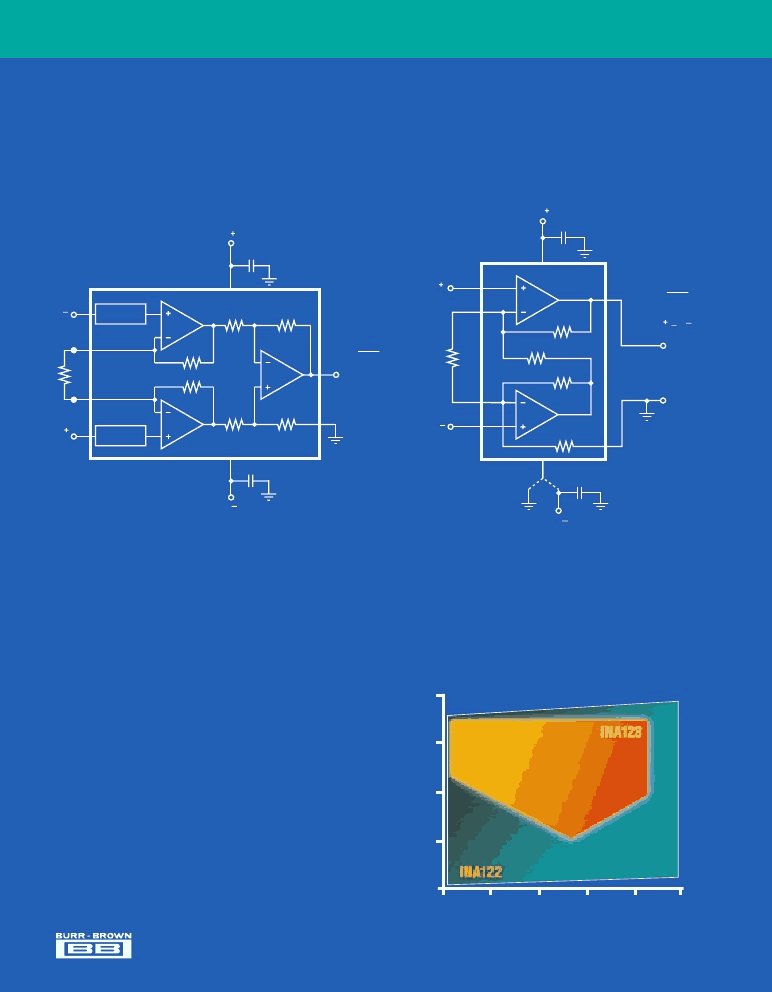- 您現(xiàn)在的位置:買賣IC網(wǎng) > PDF目錄369495 > BROCHURE Brochure - Signal Acquisition - Instrumentation Amplifier Brochure PDF資料下載
參數(shù)資料
| 型號: | BROCHURE |
| 元件分類: | 測量放大器 |
| 英文描述: | Brochure - Signal Acquisition - Instrumentation Amplifier Brochure |
| 中文描述: | 樣本-信號采集-儀表放大器手冊 |
| 文件頁數(shù): | 8/12頁 |
| 文件大?。?/td> | 492K |
| 代理商: | BROCHURE |

Burr-Brown Corporation
I
3-op-amp or in the cost saving 2-op-amp topology.
Instrumentation Amplifiers
The instrumentation amplifier is a closed–loop adjustable gain block that allows the amplification of low-level signals in the
presence of common-mode errors and noise. Burr-Brown offers many types of instrumentation amplifiers including single supply
low power high speed, low noise, and low cost devices. These instrumentation amplifiers are available either in the traditional
The two-op-amp topology can provide wider common-mode range.
Their simpler internal circuitry allows lower cost, lower quiescent
current and smaller package sizes. This topology, however, does not
lend itself to gains less than four or five.
V
IN
V
IN
Over-Voltage
Protection
Over-Voltage
Protection
A
1
A
2
25k
25k
60k
60k
60k
60k
A
3
V
0.1
μ
F
0.1
μ
F
G = 1+
50k
R
G
V
O
Ref
R
G
INA118
V
INA122
V
IN
V
IN
V
0.1
μ
F
0.22
μ
F
G = 5 +
200k
R
G
A
1
A
1
100k
100k
25k
25k
Ref
R
G
Single Supply
Dual Supply
V
V
O
= (V
IN
V
IN
) G
Single Supply Instrumentation Amplifiers
The
INA122
is designed to offer exceptional performance when
operating on a single power supply–particularly at low operating
voltage. The graph depicts the allowable common-mode input
voltage versus output voltage for the INA122 compared to the
INA128. Special input buffer circuitry extends the linear input
common-mode voltages very close to ground (or negative rail on
dual supplies).
Instrumentation Amplifier Topologies
The three-op-amp topology is the benchmark for instrumentation
amplifier performance. These devices provide a wide gain range
(down to G=1) and generally offer highest performance.
Symmetrical inverting and non-inverting gain paths provide better
common-mode rejection at high frequencies. Some types use
current–feedback type input op amps which maintain excellent
bandwidth in high gain.
I
4
3
2
1
0
0
1
2
3
4
5
Output Voltage
V
s
= +5V
V
= 2.5V, G = 1
V
REF
V
s
www.burr-brown.com
相關(guān)PDF資料 |
PDF描述 |
|---|---|
| BRT12H | Super Fast Rectifier Diodes |
| BRT12M | Super Fast Rectifier Diodes |
| BRT13H | Super Fast Rectifier Diodes |
| BRT13M | Optoelectronic |
| BRT12 | Optocoupler, Phototriac Output |
相關(guān)代理商/技術(shù)參數(shù) |
參數(shù)描述 |
|---|---|
| BROKEN BOX CHARGE | 制造商:ETRI 功能描述: |
| BROKER FEE | 制造商:Aavid Thermalloy 功能描述:- Bulk |
| BRONZE | 制造商:Brady Corporation 功能描述:BRONZE INSTALL |
| BRONZE UNIKIT | 制造商:NOGA 功能描述:DEBURRING KIT 13-PC 制造商:NOGA 功能描述:DEBURRING KIT, 13-PC |
| BROS100-22-LSO | 制造商:VESTAL 制造商全稱:VESTAL 功能描述:Bare Radial Jumper Wire With OS Crimp |
發(fā)布緊急采購,3分鐘左右您將得到回復。